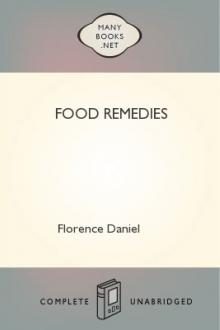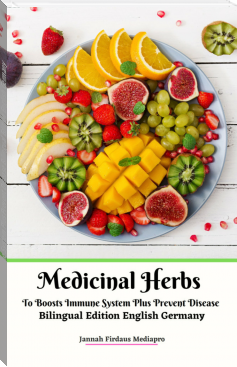Food Remedies, Florence Daniel [jenna bush book club .TXT] 📗

- Author: Florence Daniel
- Performer: -
Book online «Food Remedies, Florence Daniel [jenna bush book club .TXT] 📗». Author Florence Daniel
The berries of the elder-tree are not palatable enough to be used as a common article of food, but in the days when nearly every garden boasted its elder-tree few housewives omitted to make elderberry wine in due season.
It is not permitted to "food-reformers" to make "wine," but those readers who are fortunate enough to possess an elder-tree might well preserve the juice of the berries against winter coughs and colds.
Preserved Fruit Juice.The following is E. and B. May's recipe for preserving fruit juice. Put the fruit into a preserving-pan, crush it and allow it to simmer slowly until the juice is well drawn out. This will take about an hour. Press out the juice and strain through a jelly-bag until quite clear. Put the juice back into the pan, and to every quart add a quarter of a pound of best cane sugar. Stir until dissolved. Put the juice into clean, dry bottles. Stand the bottles in a pan of hot water, and when the latter has come to the boil allow the bottles to remain in the boiling water for fifteen minutes. The idea is to bring the juice inside the bottles to boiling point just before sealing up, but not to boil it. See that the bottles are full. Cork immediately on taking out of the pan, and then seal up. To seal mix a little plaster of Paris with water and spread it well over the cork. Let it come a little below the cork so as to exclude all air.
The juice of the elderberry is famous for promoting perspiration, hence its efficacy in the cure of colds. Two tablespoonfuls should be taken at bed-time in a tumbler of hot water.
The juice of the elderberry is excellent in fevers, and is also said to promote longevity.
Elderberry Poultice."The leaves of the elder, boiled until they are soft, with a little linseed oil added thereto," laid upon a scarlet cloth and applied, as hot as it can be borne, to piles, has been said to be an infallible remedy. Each time this poultice gets cold it must be renewed for "the space of an hour." At the end of this time the final dressing is to be "bound on," and the patient "put warm to bed." If necessary the whole operation is to be repeated; but the writer assures us that "this hath not yet failed at the first dressing to cure the disease." If any reader desires to try the experiment I would suggest that the leaves be steamed rather than boiled, and pure olive oil used in the place of linseed oil. It must also be remembered that no outward application can be expected to effect a permanent cure, since the presence of piles indicates an effort of Nature to clear out some poison from the system. But if this expulsion is assisted by appropriate means the pain may well be alleviated by external applications. (Pepper should be avoided by sufferers from piles.)
Fig.A "lump of figs" laid on the boil of King Hezekiah, as recorded in 2 Kings xx. 7, brought about that monarch's recovery. The figs used were doubtless ripe figs, not the dried figs of our grocers.
"This fruit," says Dr. Fernie, "is soft, easily digested, and corrective of strumous disease." The large blue fig may be grown in England, in the milder parts and under a warm wall. The fresh figs were rarely seen at one time outside of the large "high-class" fruit shops, but for the last year or two I have seen them peddled in the streets of London like apples and oranges in due season.
Green figs (not unripe) were commonly eaten by Roman gladiators, which is surely a sufficient tribute to the fruit's strength-giving qualities.
The best way of preparing dried figs for eating is to wash them very quickly in warm water, and steam for twenty minutes or until tender.
Grape.The special value of the grape lies in the fact that it is a very quick repairer of bodily waste, the grape sugar being taken immediately into the circulation without previous digestion. For this reason is grape juice the best possible food for fever patients, consumptives, and all who are in a weak and debilitated condition. The grapes should be well chewed, the juice and pulp swallowed, and the skin and stones rejected.
In countries where the grape cure is practised, consumptive patients are fed on the sweeter varieties of grape, while those troubled with liver complaints, acid gout, or other effects of over-feeding, take the less sweet kinds.
Dr. Fernie deprecates the use of grapes for the ordinary gouty or rheumatic patient, but with all due deference to that learned authority, I do not believe the fruit exists that is not beneficial to the gouty person. One of the most gouty and rheumatic people I know, a vegetarian who certainly never over-feeds himself, derives great benefit from a few days' almost exclusive diet of grapes.
Cream of tartar, a potash salt obtained from the crust formed upon bottles and casks by grape juice when it is undergoing fermentation in the process of becoming wine, is often used as a medicine. It has been cited as an infallible specific in cases of smallpox, but I do not recommend its use, as it probably gets contaminated with other substances during the process of manufacture. In any case its value cannot be compared with the fresh, ripe fruit. I have little doubt but that an exclusive diet of grapes, combined with warmth, proper bathing, and the absence of drugs, would suffice to cure the most malignant case of smallpox.
Sufferers from malaria may use grapes with great benefit. For this purpose the grapes, with the skins and stones, should be well pounded in a mortar and allowed to stand for three hours. The juice should then be strained off and taken. Or persons with good teeth may eat the grapes, including the skins and stones, if they thoroughly macerate the latter.
In the absence of fresh grapes raisin-tea is a restoring and nourishing drink. Dr. Fernie notes that it is of the same proteid value as milk, if made in the proportions given below. It is much more easily digested than milk, and therefore of great use in gastric complaints. Sufferers from chronic gastritis could not do better than make raisin-tea their sole drink, and bananas their only food for a time.
Raisin Tea.To make raisin-tea, take half a pound of good raisins and wash well, but quickly, in lukewarm water. Cut up roughly and put into the old-fashioned beef-tea jar with a quart of distilled or boiled and filtered rain water. Cook for four hours, or until the liquid is reduced to 1 pint. Scald a fine hair sieve and press through it all except the skins and stones. If desired a little lemon juice may be added.
Gooseberry.The juice of green gooseberries "cureth all inflammations," while the red gooseberry is good for bilious subjects. But it has been said that gooseberries are not good for melancholy persons.
Gooseberries are an excellent "spring medicine."
Lavender.It is very much to be regretted that the nerve-soothing vegetable perfumes of our grandmothers have been superseded, for the most part, by the cheap mineral products of the laboratory. Scents really prepared from the flowers that give them their names are expensive to make, and consequently high-priced. The cheap scents are all mineral concoctions, and their use is more or less injurious. A penny-worth of dried lavender flowers in a muslin bag is even cheaper to buy, inoffensive to smell—which is more than can be said of cheap manufactured scents—and possesses medicinal properties.
Lavender flowers were formerly used for their curative virtues in all disorders of the head and nerves.
An oil, prepared by infusing the crushed lavender flowers in olive oil, is recommended for anointing palsied limbs, and at one time a spirit was prepared from lavender flowers which was known as "palsy drops."
A tea made with hot water and lavender tops will relieve the headache that comes from fatigue.
Dr. Fernie advises 1 dessertspoonful per day of pure lavender water for eczema.
The scent of lavender will keep away flies, fleas, and moths.
Lemon.Lemons are invaluable in cases of gout, malaria, rheumatism, and scurvy. They are also useful in fevers and liver complaints.
I have found the juice of one lemon taken in a little hot water remove dizzy feelings in the head, accompanied by specks and lights dancing before the eyes, consequent upon the liver being out of order, in half an hour.
The juice of a lemon in hot water may be taken night and morning with advantage by sufferers from rheumatism. In the "lemon cure" for gout and rheumatism, the patients begin with one lemon per day and increase the quantity until they arrive at a dozen or more. But I think this is carrying it to excess. Dr. Fernie recommends the juice of one lemon mixed with an equal proportion of hot water, to be taken pretty frequently, in cases of rheumatic fever.
A prescription for malaria, given in the Lancet, is the following: "Take a full-sized lemon, cut it in thin transverse slices, rind and all, boil these down in an earthenware jar containing a pint and a half of water, until the decoction is reduced to half a pint. Let this cool on the window-sill overnight, and drink it off in the morning."
A Florentine doctor discovered that fresh lemon juice will alleviate the pain of cancerous ulceration of the tongue. His patient sucked slices of lemon.
A German doctor found that fresh lemon juice kills the diptheria bacillus, and advises a gargle of diluted lemon juice to diptheric patients. Such a gargle is excellent for sore throat.
Dr. Fernie recommends lemon juice for nervous palpitation of the heart.
Lemon juice rubbed on to corns will eventually do away with them, and if applied to unbroken chilblains will effect a cure.
Lemon juice is also an old remedy for the removal of freckles and blackheads from the face. It should be rubbed in at bedtime, after washing with warm water.
Lettuce.Lettuce is noted for its sedative properties, although these are not great in the large, highly-manured, commercial specimens. It is very easily digested, and may, therefore, be eaten by those with whom salads disagree in the ordinary way.
Nettle.The tender tops of young nettles picked in the spring make a delicious vegetable, somewhat resembling spinach. They are excellent for sufferers from gout and skin eruptions.
Fresh nettle juice is prescribed in doses of from 1 to 2 tablespoonfuls for loss of blood from the lungs, nose, or internal organs.
Nuts.Nuts are the true substitute for flesh meat. They contain everything in the way of nourishment that meat contains, minus the poisonous constituents of the latter. They are very rich in proteid (flesh and muscle former) and fat. In addition they possess all the constituents that go to make up a perfect food. Nuts and water form a complete dietary, although I do not suggest that any reader should try it. If he did so he would probably eat too many nuts, not realising how great an amount of nourishment is contained in a concentrated form. No one should eat more than a quarter of a pound of nuts per day, in addition to other food. A pound per day would be more than sufficient if no other food were taken. I have little doubt but that the diet of the future will consist solely of nuts and fresh fruit. After all it is the food most favoured by monkeys, and our teeth and digestive apparatus more nearly resemble those of the monkey





Comments (0)